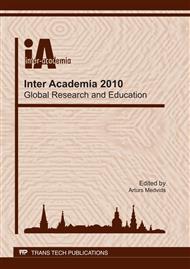p.275
p.281
p.285
p.289
p.293
p.297
p.301
p.305
p.309
Development of Combined Treatment of Electro-Coagulation and Flocculation for Various Types of Wastewater
Abstract:
This study aims at developing a new type of purification process for wastewater including suspended solids. The process consists of electrolysis and flocculation treatment (= electro-coagulation). Electrolysis was performed by applying direct current using parallel plate aluminum electrodes, and the optimal conditions were decided experimentally. The validity, as well as the purification mechanism of the process, was researched by measuring turbidity and TOC of the samples. Excellent results were obtained from treating tests for various wastewaters with different characteristics. It was suggested that colloid of aluminum hydroxide was formed by electrolysis treatment, meaning that the formation of colloid would be essential for this electro-coagulation separation. The research for aggregating agent suitable for this process was also carried out, but the best suited one was not found out because the results of flocculation test were very complicated.
Info:
Periodical:
Pages:
293-296
Citation:
Online since:
April 2011
Authors:
Price:
Сopyright:
© 2011 Trans Tech Publications Ltd. All Rights Reserved
Share:
Citation:


